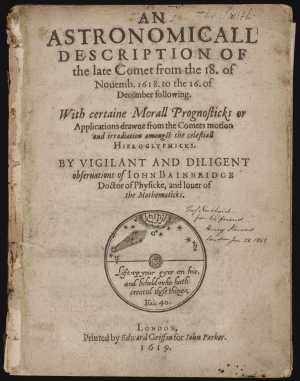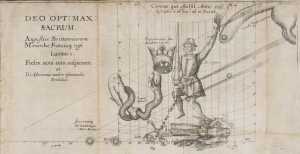John Bainbridge (1582–1643)
John Bainbridge was born in Ashby-de-la-Zouch, Leicestershire and attended the Free Grammar School there. The Grammar School buildings from Bainbridge's time no longer exist, having been destroyed in the Civil War (Hextall, p94). He then became a student at Emmanuel College Cambridge. His tutor was Joseph Hall (1574–1656) of Bristow Park, near Ashby, a relative and later bishop of Norwich. Having received his MD from Cambridge in 1614, he returned to Ashby-de-la-Zouch to set up a medical practice. He also taught in a grammar school there, though it is not clear if it was one he set up himself. Whilst in Ashby he studied mathematics and astronomy. However he remained there only a few years before moving to London.
He published a book about the great comet of 1618 in the following year. Bainbridge's astronomical work had come to the attention of Henry Savile and this led to him becoming the first Savilian Professor of Astronomy at Oxford in 1619. (Later holders of the post include Christopher Wren (1661-73) and Joseph Silk (1999-2012).) Bainbridge went to Merton College, Oxford in 1620 and stayed there for the rest of his life. He was buried in the chapel at Merton College.
 Portrait of John Bainbridge by an unknown artist
|
The painting is owned by the Bodleian Library, Oxford. From:- BBC: Your Paintings: John Bainbridge (1582–1643) |
In his inaugural lecture in 1621 as Savilian Professor, Bainbridge spoke of recent discoveries using telescopes: sun spots, the phases of Venus, mountains on the Moon, Jupiter's moons and Saturn appearing to consist of three bodies. Ptolemy's Almagest was the set text for astronomy. The mathematics was relevant for the Copernican view of the solar system as well as older ideas. In 1625 he covered the work of Galileo (1564–1642), Kepler (1571–1630) and Christoph Scheiner (1573–1650), who studied sun spots (Tyacke, p247). The Savilian professor was not allowed to teach astrology in any form (Catt, p86-7).
In the 1620s he began learning Arabic in order to read astronomical observations in medieval Arabic sources and, with the help of other scholars, he studied several books. He left several manuscripts when he died, but not all were printed. In his will he left the manuscripts to Archbishop Ussher (1581–1656). Bainbridge had corresponded with Ussher, because of the latter's interested in astronomy with regard to chronology (Tyacke p249). Bainbridge's papers are now in the library of Trinity College, Dublin.
Joseph Justus Scaliger (1540-1609) had done important work on chronology, including studying the rising of Sirius at dawn as used by the ancient Egyptians. However, Bainbridge discovered errors in his work. His work was published after his death, with the title Canicularia, in 1648, by John Greaves, (1602–1652) who succeeded Bainbridge as Savilian Professor of Astronomy.
Bainbridge was involved in finding ways of determining longitude. He gave instructions to the mariner Roger Fry who set out for Guiana in 1631, wanting observations from nearer the equator. In 1633, despite being captured by the Portuguese, Fry was able to sent back observations made on the coast of of Brazil. These included a solar eclipse of 29 March 1633 (8 April 1633 New Style), which was visible as a partial eclipse in Britain. Bainbridge used the results to calculate the longitude of the site in Brazil. Another expedition that he organised involved John Greaves travelling to Constantinople in 1637. Greaves intended to observe a lunar eclipse, and arranged for simultaneous observations to be made at four different locations. The results would be used to calculate longitude. Greaves then went to Alexandria where he spent six months observing stars, another aim of his journey being to check the results of the ancient Greeks (Tyacke, p251).
Observations
Bainbridge was one of the first astronomers to observe a comet using a telescope (1618) and estimated that the distance to the comet to be at least ten times that of the Earth and the Moon (Catt, p85).
One of the conditions of being Savilian Professor was that he had to make his own instruments and observations (Catt, p85). He observed lunar and solar eclipses
In 1623 he calculated the latitude of Oxford (Catt, p86).
He hoped to observe the 1631 transit of Venus, using a telescope to project the image of the Sun onto a screen. However there was an error in Kepler's calculations predicting the transit and it was not visible from Europe (Tyacke, p250).
Publications
|
Title page of An Astronomical Description of the Late Comet, 1619.
|
An Astronomical Description of the Late Comet, 1619. Click on image for larger version. |
|
Chart showing the path of comet in the sky. |
Click on image for larger version. |
Translations of De Sphaera, Proclus [an astronomical treatise], and De Planetarum Hypothesibus [Planetary Hypotheses], Ptolemy, 1620.
Canicularia [Concerning the Dog Star],1648.
Published posthumously by John Greaves. The title refers to Sirius.
Epitaph
Translation of the Bainbridge's epitaph. The original is in Latin.
If passenger, you would know who, and how great a man lies here, you must enquire elsewhere; I cannot sufficiently inform you; all Britain is too little for his fame. But that you may not be ignorant of the rest, take the following account for your benefit. John Bainbridge, a person of the most unblemished character, and unequalled learning, Professor of Physic and Mathematics, as successful in removing new diseases, as sagacious in his observations on the stars; whom Sir Henry Savile that excellent judge of men and books, appointed his first Professor of Astronomy, and his worthy colleague in the mathematical lectures he had so nobly founded; who, having been educated at Cambridge, was cherished by the university of Oxford as her own son, and honoured by her with a public oration and funeral, as equally an ornament of both; who corrected Scaliger with more success than Scaliger had corrected Chronology; died too early for the interest of learning in the year 1643. Go now and learn the rest even from foreigners.(Biographia Britannica, p420)
References
Apt, A. J., 'Bainbridge, John (1582-1643)', Oxford Dictionary of National Biography, Oxford University Press, 2004; online edn, Jan 2008 [http://www.oxforddnb.com/view/article/1082, accessed 16 Sept 2012].
Bainbridge, John, An Astronomical Description of the Late Comet.
Electronic versions, via Early English Books Online, for those who can log in to the University of Leicester Library Catalogue (and other academic institutions): 1618 and 1619 editions.
The two images from An Astronomical Description of the Late Comet are from the website of the Beinecke Rare Book and Manuscript Library, Yale University: the title page and a chart showing the path of the comet in the sky.
Bainbridge, John, Canicularia, 1648. Electronic version, via Early English Books Online, to those who can log in to the University of Leicester Library Catalogue (and other academic institutions): Canicvlaria : una cum demonstratione ortus Sirii heliaci, pro parallelo inferioris Aegypti
Bainbridge, John. Some of his manuscripts are in Trinity College Dublin Library.
Biographia Britannica: Or the Lives of the Most Eminent Persons who Have Flourished in Great Britain from the Earliest Ages Down to the Present Times, Volume 1, Volume 1, 1747. p419-21.
Catt, Patrick, A., The Biographical Encyclopedia of Astronomers, Volume 2, pp85-6
Dictionary of National Biography: Bainbridge, In Wikisource, The Free Library. Retrieved 14:38, October 12, 2012.
Feingold, Mordechai, The Mathematician's Apprenticeship: Science, Universities and Society in England 1560-1640, 1984. p143-9.
Hextall, W & J, The History and Description of Ashby-de-la-Zouch; with excursions in the neighbourhood, 1852. (later facsimile reprints])
Hillier, Kenneth, The Book of Ashby_de-la-Zouch, 1984. p41, 44.
NASA: Path of annular solar eclipse of 08 April 1633.
Nichols, John, The history and antiquities of the county of Leicester : Vol. 3, Part 2. p630-32.
Note: Nichols says Bainbridge's mother was Alice Everard. Her name was Anne.
Scott, W., The Story of Ashby-de-la-Zouch, 1907. (1975 facsimile)
Tyacke, Nicholas, Aspects of English Protestantism C. 1530-1700, 2002. p247, 249-51.
Note:
The online version of the Oxford Dictionary of National Biography is available to members via City of Leicester Libraries Online Reference Room and Leicestershire County Council Libraries Online Reference Library.
Last updated 30th July, 2013.


